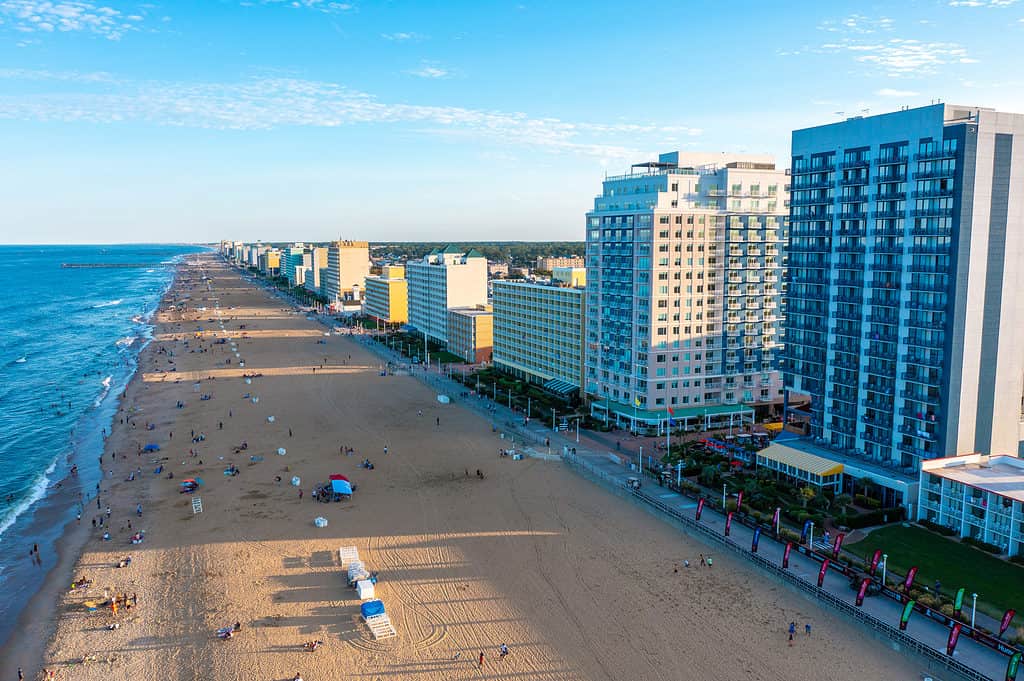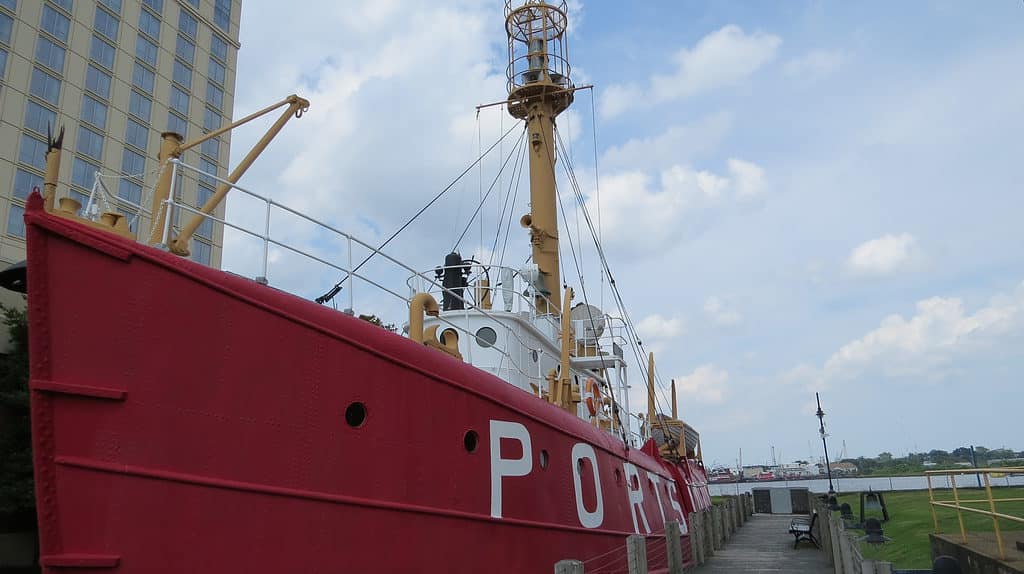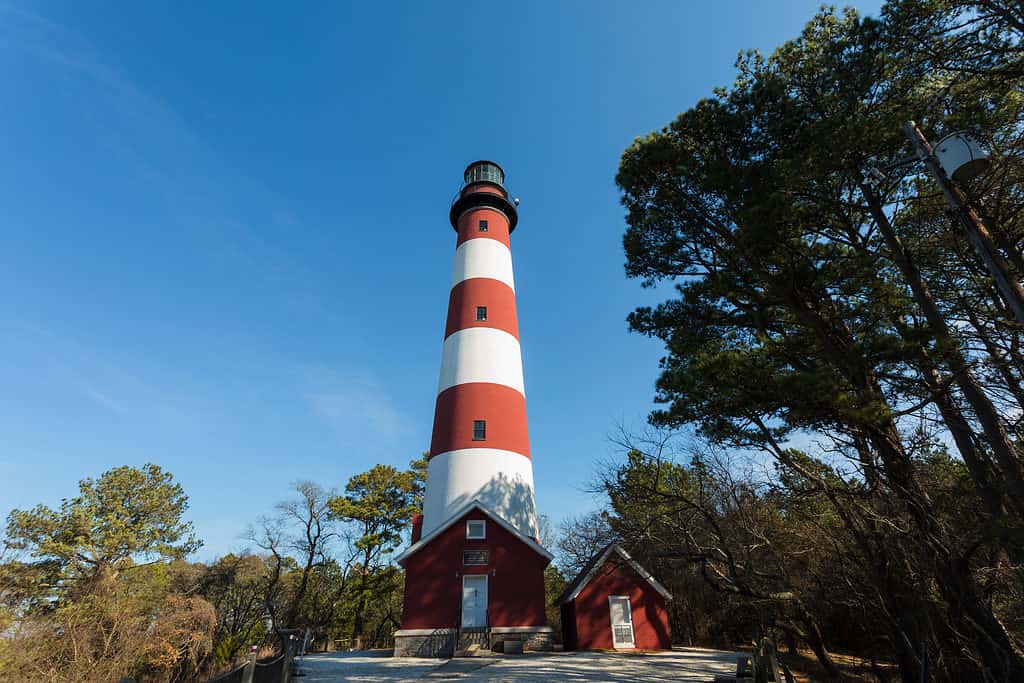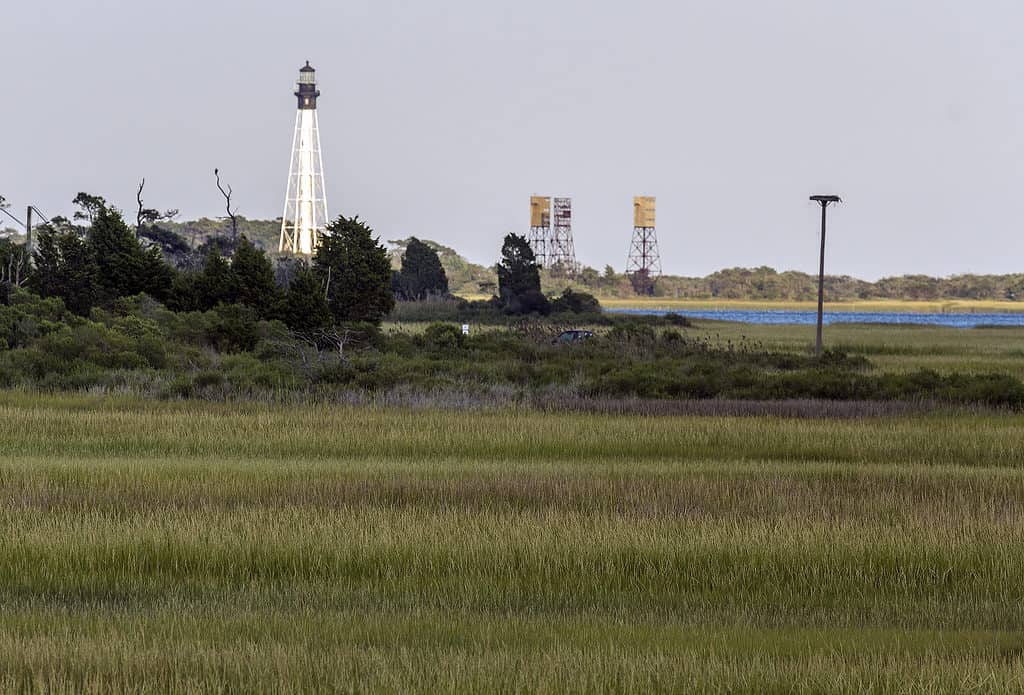Virginia Beach is a small city on the coast of the state of Virginia, right where the Atlantic Ocean and the Chesapeake Bay converge. It is famous for its scenic boardwalk, beautiful shoreline, and the original landing point of the English settlers who established Jamestown. It is also home to some of the East Coast’s most beautiful lighthouses, some of which are among the oldest in the country. Read on to discover more about these historic structures if you plan to visit Virginia any time soon!

Virginia Beach is famous for its scenic boardwalk and beautiful shoreline.
©iStock.com/Kyle Little
1. Cape Henry Lighthouse
Cape Henry lies at the intersection of the Atlantic Ocean and the Chesapeake Bay, and it provides entry to ports in several nearby states, including Maryland, Washington D.C., and the Virginian towns of Newport News and Norfolk. With such heavy maritime traffic, this area was in great need of a guiding light to deter the rampant piracy that occurred in Cape Henry and to help cargo ships in harrowing weather.
History
Tobacco merchants amplified the persistent plea for a lighthouse in 1758, echoing a demand made for 70 years. In response, the local Lighthouse Board finally relented. By 1772, the foundational resources and lodgings for the construction crew were secured. However, the Revolutionary War’s eruption against Britain halted the endeavor.
Once peace returned, construction of the Cape Henry Lighthouse resumed, marking the inaugural lighthouse project greenlit by the nascent United States of America. The tower’s foundation utilized the identical sandstone featured in iconic structures like the U.S. Capitol, Mount Vernon, and the White House.
To expedite matters, Virginia generously allocated several land acres. Under John McComb Jr.’s supervision, the Cape Henry Lighthouse, with its impressive ninety-foot stature, was completed in October 1792 at a cost of $17,700. Its first-order Fresnel lens, a remarkable feat of engineering, remains operational.
However, the lighthouse wasn’t spared the ravages of the Civil War. In 1861, the Confederacy inflicted damages on the structure. But by 1863, Union forces diligently restored its former glory. Years of relentless wear necessitated another intervention. Thus, in 1881, a new one-hundred-fifty-seven-foot Cape Henry tower emerged, a mere three hundred and fifty feet from its predecessor, at a cost of $75,000.
The Lighthouse Today
Despite worry over its condition, the original Cape Henry Lighthouse is still standing today. Both towers are currently housed on the Fort Story Military Reservation, though only the first tower is open to the public. It is the fourth oldest lighthouse in America and a common tourist attraction for those visiting Virginia. In 1964 it was designated as a National Historic Landmark.

The first Cape Henry Lighthouse was completed in 1792, and then in 1881, a second, new lighthouse was built only 350 feet away from the first.
©iStock.com/Tim Pennington
2. Lightship Portsmouth
Lightships have a unique chapter in U.S. history. From April 1820 to March 1985, these ships provided guidance where traditional lighthouses were impractical. At their peak, 179 lightships marked 116 locations across the Pacific and Atlantic Oceans and the Great Lakes.
History
Built by the seasoned shipbuilders of Pusey and Jones in Wilmington, Delaware, the Lightship Portsmouth, also known as LV 101 or “Charles,” emerged in 1915 and was operational by January 12, 1916. This company, which started in 1853, crafted the ship for $108,507. Stretching 102 feet, the ship’s unique “whaleback” steel hull was tailored to handle rough seas. The mast’s hollow design permitted the crew to use an internal ladder, ensuring they could manage the light tower regardless of external conditions.
Manned by an eleven-strong crew from the United States Lighthouse Service, the ship’s maiden voyage was at Cape Charles, Virginia. From 1916 to 1924, it underwent enhancements, receiving radio tech and acetylene lamp illuminants. Subsequently, from 1926 to 1951, it anchored at Overfalls Shoal, Delaware.
After serving through two World Wars and standing strong for forty-eight years, 1964 marked the decommissioning of LV 101. It found a final berth in Portsmouth, Virginia. Over the next three years, dedicated volunteers painstakingly restored the ship, turning it into an enticing maritime museum and attraction. The public got their first look at the refurbished Lightship Portsmouth in 1967 at the Portsmouth Naval Shipyard Museum. The vessel’s rich history earned it a spot as a National Historic Landmark in 1989.

The Lightship Portsmouth was once used to guide ships with its light where lighthouses were not feasible.
©darlingtrk / Flickr – License
3. Assateague Lighthouse
Assateague Lighthouse stands on Assateague Island, a barrier island nearly 40 miles long, divided between Virginia in the south and Maryland in the north. In March 1831, the United States Congress allocated $75,000 for a lighthouse in response to decades of shipwrecks in the area.
A purchase secured the designated fifty acres for $440 the following year. Noah Porter, the same architect behind the Ocracoke Island Lighthouse, started building the forty-five-foot tower and the lighthouse keepers’ quarters in 1832. By spring 1833, he had completed the project.
History
By 1850, the Assateague Lighthouse needed repairs. In 1856, workers installed a third-order Fresnel lens. However, they decommissioned the tower just two years later, planning to build a new one. On June 20th, 1860, the United States Congress allocated $50,000 for the second lighthouse’s construction. But the Civil War that erupted the next year delayed these plans.
So, during the war, the original Assateague Lighthouse continued its operation. Only after the war’s conclusion in 1865 did construction of the new tower genuinely kick-off. Due to increasing costs, Congress had to pitch in another $25,000 in July 1866. By October 1st, 1867, workers had completed the second Assateague Lighthouse and the keeper’s quarters. This new structure stood at a height of one-hundred-forty feet, boasting a first-order Fresnel lens that reached nineteen miles across the water.
In 1933 the lighthouse received electricity, and in 1961 the Fresnel lens was retired, and in its place, the Assateague Lighthouse runs a DCB (directional coded beacon). The renovated lighthouse keeper’s quarters are big enough to fit three separate keepers and their families, and the premises are located amidst the Chincoteague National Wildlife Refuge, making the Assateague Lighthouse a perfect spot to visit if you find yourself in Virginia Beach.
The Lighthouse Today
The tower still guides ships today, and in 2004 the United States Coast Guard relinquished control to the United States Fish and Wildlife Service. The Assateague Lighthouse is available for free to the public every weekend from April to November from 9 am to 3 pm. It is highly recommended for its serene location and panoramic views from the top of the tower.

The Assateague Light House on Assateague Island was built in 1833 and still guides ships today.
©christianthiel.net/Shutterstock.com
4. Cape Charles Lighthouse
The First Lighthouse
The Cape Charles Lighthouse is both the tallest tower in the state of Virginia and the second-tallest tower in the country, after the Cape Hatteras Lighthouse. It was built on the north side of the Chesapeake Bay, just across the water from the Cape Henry Lighthouse. In 1826 the United States Congress approved $10,000 for the construction of the lighthouse, and it was completed a year later in 1827, standing fifty-five feet tall.
The Second Lighthouse
The cape of Smith Island was notoriously prone to erosion. By August of 1856, Congress found it necessary to provide an additional $35,000 in order to build a second Cape Charles Lighthouse further in from the first one. Unfortunately, their timing could not have been worse, as the American Civil War was just about to erupt, further delaying the completion of the second tower until September of 1864.
United States Congress again had to appropriate money to help finish the Cape Charles Lighthouse, this time administering another $20,000 and providing troops to help guard the premises while it was being completed during a war. This new tower stood one-hundred-fifty feet tall and only operated for another 28 years before the ever-shifting beachfront of Smith Island again demanded intervention.
The Third Lighthouse
Every year, the sea consumed thirty feet of the shoreline. By 1883, the Lighthouse Board had started devising a new strategy. Congress funded a $10,000 jetty construction to combat the sea’s encroachment. However, by 1888, the sea was eroding the jetty’s walls even before its completion.
In 1889, the strategy shifted. Congress allocated $150,000 to establish a third station at Cape Charles. The team had to erect new jetties for the tower’s construction. By July 1892, they completed all preliminary tasks, including land acquisition.
Construction of the third and last Cape Charles Lighthouse spanned three years and cost $78,200. With its first-order Fresnel lens installed, the tower began operations in August 1895.
In 1933, the Cape Charles Lighthouse received electricity. Its Fresnel lens got replaced by a DCB when automated in 1963. Standing at one-hundred-ninety-one feet, the Coast Guard now manages it. While the public can’t enter the lighthouse, visitors can journey to Smith Island to admire its magnificence.

Cape Charles Lighthouse in Virginia stands one-hundred-ninety-one feet tall and is currently operated by the Coast Guard.
©Acroterion, CC BY-SA 3.0 <https://creativecommons.org/licenses/by-sa/3.0>, via Wikimedia Commons – License
5. New Point Comfort Lighthouse
The sixty-three feet tall New Point Comfort Lighthouse is the third-oldest lighthouse on the Chesapeake Bay and the tenth-oldest in America. Located at the meeting point of the York River and Mobjack Bay, Elzy Burroughs built the New Point Comfort Lighthouse in 1805, following a commission from President Thomas Jefferson.
Understanding the crucial role of Chesapeake Bay in the transport of goods and the budding U.S. economy, the government quickly recognized the significance of having a lighthouse there. Interestingly, the New Point Comfort Lighthouse shares a connection with the Cape Henry Lighthouse; builders sourced sandstone for both from the same quarry that also provided for the Capitol building and the White.
History
Starting its operations on January 17, 1805, the lighthouse consistently aided the course of trade vessels. However, during the War of 1812, the British Royal Navy brought destruction to both the tower and the keeper’s quarters. These structures underwent reconstruction in 1855, and by 1865, a fourth-order Fresnel lens enhanced the tower’s reach, enabling its beam to cover 13 miles across the Bay’s waters.
Remarkably, the New Point Comfort Lighthouse had James McHenry Farley, one of the few recorded African-American lighthouse keepers and a preacher, overseeing it from 1871 to 1873. The lighthouse witnessed automation in the early 1920s and transitioned to electricity by 1960. However, it concluded its official service in 1963.
The Lighthouse Today
Earning its title as a National Historic Landmark in 1972, Mathews County took ownership of the lighthouse in 1975. With support from local volunteers and the Virginia Department of Conservation and Natural Resources, restoration efforts commenced. Presently, the lighthouse welcomes visitors, though one must reach it by boat, as neither cars nor walking paths provide access.

The New Point Comfort Lighthouse is the third-oldest lighthouse on the Chesapeake Bay and the tenth-oldest in America.
©Rachel Ramey/Shutterstock.com
The photo featured at the top of this post is © Kosoff/Shutterstock.com
Thank you for reading! Have some feedback for us? Contact the AZ Animals editorial team.







